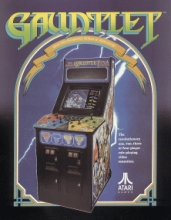|
In this exploration /
shooting game with RPG elements, one to four players
choose a character and explore the depths of a
multi-level dungeon; destroy monsters by shooting,
fighting or using magic potions; and collect
power-ups to last longer. Controlled with an 8-way
joystick and two buttons.
- TRIVIA -
When Gauntlet was introduced, it was a major
technological achievement in arcade game design (So
much so, that this game has been on at least two
nation-wide museum tours). In the mid-1980's, the
popularity of pen-and-paper role-playing games such
as 'Dungeons & Dragons' was at its height. Still hot
from the success of "Marble Madness" and "Paperboy",
Atari Games created a game to capitalize on the
current craze. In fact, what they DID create was a
game that had an ambience that extended much further
than the confines of the cabinet, and made them a
LOT of money.
Gauntlet was based on a computer game called 'Dandy'
for the Sinclair ZX Spectrum. Jack Palevich, the
author of Dandy, planned to sue Atari for
plagiarizing their design, but he got a 'free'
Gauntlet machine from Atari Coin-op. In return, he
signed papers saying that he wouldn't try to sue
them (He took the Gauntlet machine into work....). |
 |
|
One of the most acclaimed features of Gauntlet was
the extensive speech used throughout the game. The
speech was not only used for effect ('Elf has been
eating all the food lately'), but also for
instruction in the early levels ('Save potions for
later use'). At the time, games with that level of
synthesized speech were unheard of. The sheer amount
of enemies (and in some cases, the monster
generators made that amount seem endless) was
another lauded feature. Last, but certainly not the
least, was the fun factor of the game. Four people
trying to coordinate their movements is anything but
un-entertaining, even today!
Approximately 8,000 units were produced.
Note : There were 20 officially released versions
(see Updates section for detailed info), including
six 2-players versions and various Spanish, German
and Japanese versions. Counting 4-players English
variants alone, there were seven releases with
various bug fixes.
Note 2 : The game contains exactly 212 sounds!
(including digitized voices, effects and music).
The default high score screen of "Cyberball 2072"
features names of many Atari arcade games, including
GAUNTLET.
Pony Canyon / Scitron released a limited-edition
soundtrack album for this game (That's Atari Music
Vol.II : G.S.M. Atari Games 2 - PCCB-00070) on
21/09/1991.
- TIPS AND TRICKS -
* If you remain motionless (or basically aimless)
and stall off about 30 health, all of the doors
will open. Everybody knows this, and the game even
tells you about it. The game doesn't tell you that
if you stall off about 200 health, all the walls
will turn into exits! (work on Revision 6 and +) The
game designers had to include this because there are
some levels which require you to pick up a key
before you exit. If you are already filled up with
keys, and the doors are all gone, then it would be
IMPOSSIBLE for you to exit, and you would starve to
death. What they didn't anticipate, is that certain
levels of the game which are really difficult, which
would require you to take massive health losses to
finish, become very simple if all the walls are
exits. Or they can be effectively skipped
altogether. Because the game has Monty-Hall levels
with lots of food on them, you can use this cheat to
only play levels which are a wash or increase your
health dramatically, and cut your losses to 200
on all the really hard levels.
* The best character to play, in the LONG run, is
the elf. His magic is just as good as the wizard's
and his fight ability as good as Thor's. His ability
to shoot through cracks in addition to all this
(when he has the power potions) makes him the best.
The Valkyrie is the worst, although some people
regard this as a challenge...
* To manipulate the point value of Death, shoot him.
Death's point value takes the following
progression :
1000-2000-1000-4000-1000-6000-1000-8000, and then
back to start. His value keeps from the previous
game.
* You can kill Death painlessly by teleporting on
top of him.
* Level 8 is the level that the previous game ended
on. If you got a really good sequence of boards in a
game and you want to repeat them, turn the machine
off and on again after you've entered your high
score.
- STAFF -
Designer / Programmer : Ed Logg (ED )
Game programmer : Bob Flanagan (BF )
Video graphics : Sam Comstock (SWC), Susan G.
McBride (SGM), Alan Murphey, Will Noble, Dave
Pettigrew
(D F)
Engineer : Pat McCarthy (PMC)
Technician : Sae Oh (SMO), Cris Drobny (CAD)
Sound designers : Hal Canon (HAL), Earl Vickers
(EAR)
Cabinet designer : Ken Hata (KEN)
- PORTS -
* Consoles :
Atari Lynx (1990)
Sega Master System (1990)
Sony PlayStation (1998, "Arcade's Greatest Hits -
The Atari Collection 2")
Sega Dreamcast (2000, "Midway's Greatest Arcade Hits
Volume 2")
Sony PlayStation 2 (2003, "Midway Arcade Treasure")
Nintendo Gamecube (2003, "Midway Arcade Treasure")
Microsoft XBOX (2003, "Midway Arcade Treasure")
Sega Mega Drive
* Computers :
Amstrad CPC (1985)
Atari ST (1985)
Sinclair ZX Spectrum (1987)
PC [CD-Rom] (1999, "Arcade's Greatest Hits - The
Atari Collection 2")
Commodore C64
Apple II
* Others :
LCD handheld game (1988) released by Tiger
Electronics : Contains 9 stages in your quest to
find the
long-lost Sacred Orb. There are 5 different worlds
for your search through and battle evil demons :
The Castle, The Dark Forest, The Lost Caverns, The
Unseen, and Volcana.
Source M.A.M.E |